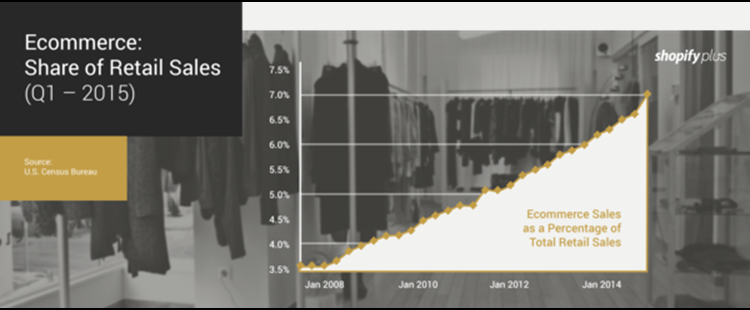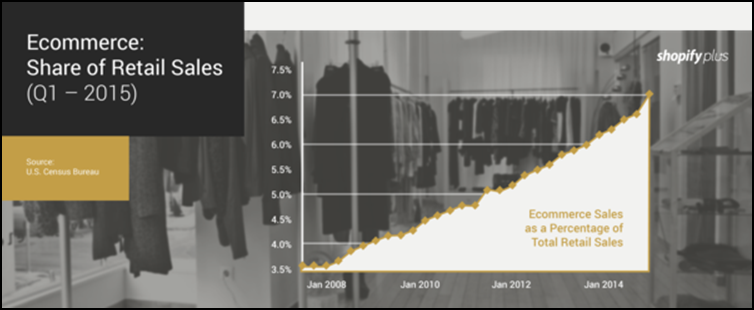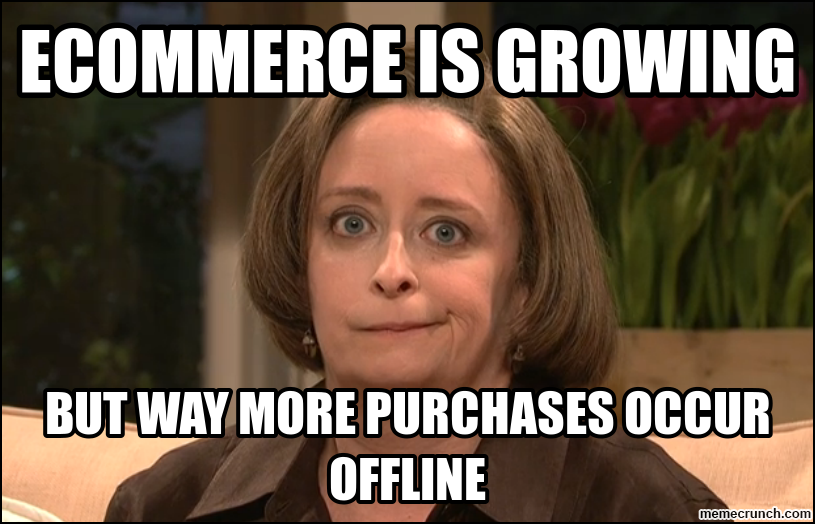Ecommerce is killing it! My inbox is filled with press pitches about the growth of ecommerce this holiday season, based on vendors’ work with their customers:
- Year-over-year revenue from social rose by 115 percent, Renee Newby Friedman wrote, based on MarketLive data.
- Online shopping traffic was up 16% year-over-year, according to Monetate. “Signs are pointing to this holiday season being big for ecommerce,” Lucinda Duncalfe, CEO, said.
- Smartphones saw a 7% increase in revenue compared to 2014, according to Wendi Makuch, Director of Sales & Marketing, 4-Tell.
- Average order value (AOV) increased more than 10 percent for Cyber Monday sales, based on Springbot data.
Sure, ecommerce is hot …
Ecommerce is hot right now, no doubt. Sales continue to rise. Investor money keeps flowing into companies that sell through the ecommerce channel along with the technology to support it. And brands are on the hunt to hire ecommerce talent. Good stuff!
Tommy Walker, Editor-in-chief of the Shopify Plus Blog, recently sent me some great data from the U.S. Census Bureau that speaks to the impressive growth — ecommerce, as a percentage of sales, has doubled since 2008. Exciting!
Now let’s you and I step out of the ecommerce bubble of all of that excitement for just a moment. Take a closer look at the above chart. Up-and-to-the right at a fairly steep grade. Growth. It’s what we all like to see.
But look at the numbers on the y-axis. That huge growth means that ecommerce still only represents seven percent of all retail sales.
93% of total retail sales are not occurring through ecommerce
Which means customers are spending way more money offline.
Wah-wah.
I know what you’re thinking. “Daniel, why are you being such a Debbie Downer? And during a holiday sales season that the National Retail Federation forecasts will be robust, with online sales growing between six and eight percent?” (Please note, that’s $105 billion online, but still, the entire pie is projected to be $630.5 billion. That 17% of all holiday sales is a bigger share of the pie than the 7% represented by total retail sales, but still way more sales are happening offline.)
Because …
Hype blinds us
But the hard truths can help us see our efforts in a whole new light — through the customer’s eyes. And the customer doesn’t care about a sales channel. Even one as robust and exciting as ecommerce.
I, too, was in the ecommerce bubble my friends. But the insights gained from customer research helped bring me to the “a-ha” moment I am sharing with you today.
It was an August day like any other. Here in Florida, that means hot, hot hot. And we were getting back the results of research conducted by MarketingSherpa (MarketingExperiments’ sister publication) with a nationally representative sample of 2,021 consumers.
One of the questions we asked was — “In which of the following ways, if any, do you learn about new products you would like to purchase? Please select all that apply.”
I just knew that “using a search engine” was going to crush it. And my bias is likely inherent in the research, since I helped choose the options we gave consumers to respond to. However, the most popular option was …
59% of consumers learn about new products they would like to purchase through in-store browsing
And among some demographics, in-store browsing was even more popular — 69% of 55-64-year-old women learn about new products through in-store browsing.
(In fairness, “using a search engine” was the third-most popular option overall with 47% responding to that option. And it did even better in some demographics. Most surprisingly, men age 65 and above — 57% chose using a search engine, and 57% also selected in-store browsing).
This discovery knocked me out of the bubble. Sure, in my ecommerce-centric view of the world, search engines loom large. But that is still a big fish in a small pond — remember, 93% of retail purchases are not happening through ecommerce.
And you may be thinking — but, lower costs. And scalability. Shrinkage. Inventory management.
These are all advantages of ecommerce over brick-and-mortar. But that type of thinking focuses on business drivers and overlooks the holistic customer experience.
Why it is essential to step out of the ecommerce bubble
So today, I implore you — you must step of out of the ecommerce bubble to truly understand the customers’ buying journey and the experiences they seek.
Even if you work for a brand with physical locations, the way many retailers are organized internally, you may operate as a separate business unit. Or at the very least, be totally focused on your territory and not understand how customers experience your product in stores.
After all, while I shared some fun ecommerce statistics in the beginning of this post, there is much room for improvement. Conversion rates were down 12%, according to Monetate. “Gains would have been higher had lower conversion rates not erased some of the gains,” Renee Newby Friedman wrote based on MarketLive’s data.
Conversion rates aren’t everything (more on that in a bit), but it does raise the question — how can you learn from customers’ preference for in-store browsing to improve ecommerce performance?
There are three questions that you can ask yourself once you step out of the ecommerce bubble to increase your ecommerce conversion:
1. How can I mimic the tangibility of in-store browsing on a website?
When we strip away the technology, here’s all that ecommerce comes down to — trying to communicate tangible value for an intangible product. Customers can’t touch and feel the way they can in-store.
Does your product-level value proposition bring clarity to the value of owning this product? And what product details page testing can you run to improve that value proposition? My colleague Jon Powell of MECLABS Institute was able to increase sales 83% by testing changes to the product details page template.
2. How can I replicate product discovery of in-store browsing in a digital environment?
Ecommerce makes it much easier for customers to quickly find exactly what they are looking for, but much more difficult to serendipitously discover what they never knew they wanted. User experience testing and conversion rate optimization is often hyper-focused on removing all obstacles between customer and purchase.
What if customers don’t always want that? For example, Gregory Casey of eBags actually went into customers’ homes to learn how they shopped, and what he discovered informed its eBags Obsession mobile site that aims not just to sell product, but to create a delightful browsing experience for the customer.
3. How can you improve the customer experience online to make shopping as enjoyable as in-store browsing?
Brick-and-mortar shopping is far more than just about product acquisition. It is an experience. It finds that music tempo variations can significantly affect the pace of in-store traffic flow and dollar sales volume. As Dr. Ronald E. Milliman discovered, even a basic element of the customer experience like background music can affect the behavior of shoppers. Simply put, customers who spend time (because of a pleasant experience) spend money as well.
And consumers increasingly value the experience. In writing about the stigma of concpicous consumption that arose during the economic downturn, Jean-Marc Bellaiche, Antonella Mei-Pochtler and Dorit Hanisch of Boston Consulting Group advised that brands must refresh the retail experience — “Luxury companies have spent years developing retail networks that reflect a monolithic, global identity. This model needs to be updated as consumers seek out experiences, cultural relationships and unique product discoveries that bond them to a brand.”
We’ve already discussed product discovery — what can you do to improve the experience on your website? For example, Amazon offered free holiday playlists on its website. And while conversion is important, can you raise the value of metrics such as time on site and repeat visits? As David Brussin, Executive Chairman, Monetate, told me “Customers are pickier about which brands they engage with — they want more from that interaction” as he made the case for why lower conversion and add-to-cart rates aren’t always a bad thing.
The holiday shopping season is almost over. And you’re extremely busy, I know.
But before December 25, do the unthinkable. Step out of the ecommerce bubble. And go to the mall. Or Main Street. A farmer’s market. The local shopping square. A brick-and-mortar location of your brand. Visit the physical shopping environment and do a little research. Just stop and notice how customers experience the shopping environment and interact with products in the physical world.
Then think about what you can leverage from this experience on your ecommerce site in 2016.
You can follow Daniel Burstein, Director of Editorial Content, MECLABS Institute, @DanielBurstein.
You might also like
MarketingSherpa Summit 2016 — At the Bellagio in Las Vegas, February 22-24
Landing Page Mistakes: E-commerce sites treating new and returning visitors the same
Cyber Monday 2015 recap: 3 notable marketing trends for online merchants (from Springbot)
Black Friday was for Shoppers Cyber Monday was for Buyers: 2015 Holiday Online Sales Analysis (from 4-Tell)
Ecommerce Chart: The most important ways to improve customers’ shopping experiences (from MarketingSherpa)
Quarterly Retail Ecommerce Sales, 3rd Quarter of 2015 (from the U.S. Census Bureau)
Value Proposition Development online course (from MarketingExperiments’ parent research organization, MECLABS Institute)





